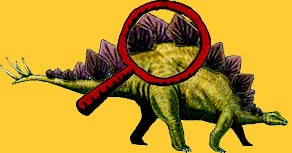


![]()
Artists
like John Payne like to know how a dinosaur behaved as well as what
it looked like. Knowing this helps them create realistic dinosaur
art.
But scientists don't always know how dinosaurs behaved! Scientists study fossils and make educated guessesóor theoriesóabout dinosaur life based on this evidence. Sometimes new fossils strengthen a theory, but other times they can prove it wrong.
 Here
are several dinosaur body parts. What do you think they might
have been used for?
Here
are several dinosaur body parts. What do you think they might
have been used for?
Imagining
Dinosaurs
Artists
and scientists draw, paint and sculpt how they think dinosaurs looked
like. Their art reflects the ideas and beliefs of their time. When
the first fossils of the Iguanodon were found, scientists thought it
walked on all fours. Now we think that this dinosaur walked
upright.
|
|
|
 Dragon
or Dinosaur?
Dragon
or Dinosaur?
Thousands
of years ago, Chinese peasants probably found dinosaur bones as they
farmed. Some people believe that these huge bones helped inspire
the first legends of dragons in ancient China (as in the painting on
the left). Not until the 1830s, when scientists began examining
dinosaur bones more closely, was the truth about these prehistoric
animals discovered.
And theories about dinosaurs are changing even today. For over one hundred years, scientists have thought that the gigantic sauropods like Brachiosaurus and Apatosaurus used their long necks to eat leaves atop tall trees.

But new research suggests that their necks could not rise above their bodies. Instead, they may have swung their long necks back and forth to graze on grasses and marshes!
As
we learn more about dinosaurs, outdated ideas might seem a little
silly. But only by imagining dinosaurs can we think of new answers to
questions. And it's fun! Try it yourself!
|
|
Kinetosaurs Home Page
Copyright 1999 The Children's Museum of Indianapolis